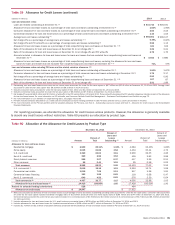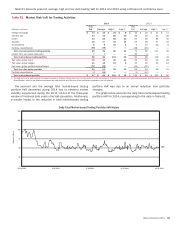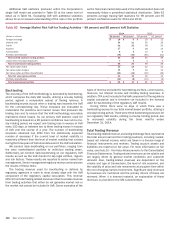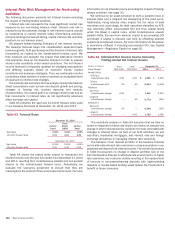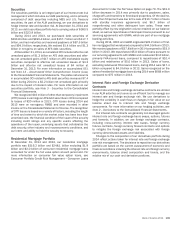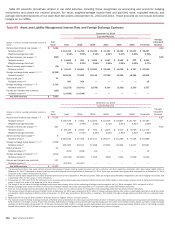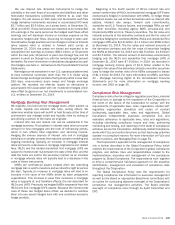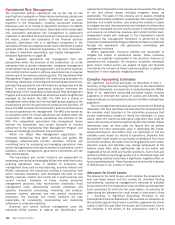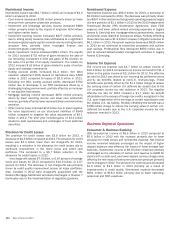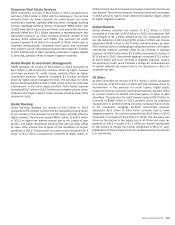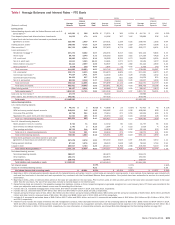Bank of America 2014 Annual Report Download - page 107
Download and view the complete annual report
Please find page 107 of the 2014 Bank of America annual report below. You can navigate through the pages in the report by either clicking on the pages listed below, or by using the keyword search tool below to find specific information within the annual report.Bank of America 2014 105
We use interest rate derivative instruments to hedge the
variability in the cash flows of our assets and liabilities and other
forecasted transactions (collectively referred to as cash flow
hedges). The net losses on both open and terminated cash flow
hedge derivative instruments recorded in accumulated OCI were
$2.7 billion and $3.6 billion, on a pretax basis, at December 31,
2014 and 2013. These net losses are expected to be reclassified
into earnings in the same period as the hedged cash flows affect
earnings and will decrease income or increase expense on the
respective hedged cash flows. Assuming no change in open cash
flow derivative hedge positions and no changes in prices or interest
rates beyond what is implied in forward yield curves at
December 31, 2014, the pretax net losses are expected to be
reclassified into earnings as follows: $803 million, or 30 percent
within the next year, 46 percent in years two through five, and 16
percent in years six through ten, with the remaining eight percent
thereafter. For more information on derivatives designated as cash
flow hedges, see Note 2 – Derivatives to the Consolidated Financial
Statements.
We hedge our net investment in non-U.S. operations determined
to have functional currencies other than the U.S. Dollar using
forward foreign exchange contracts that typically settle in less than
180 days, cross-currency basis swaps and foreign exchange
options. We recorded net after-tax losses on derivatives in
accumulated OCI associated with net investment hedges which
were offset by gains on our net investments in consolidated non-
U.S. entities at December 31, 2014.
Mortgage Banking Risk Management
We originate, fund and service mortgage loans, which subject us
to credit, liquidity and interest rate risks, among others. We
determine whether loans will be HFI or held-for-sale at the time of
commitment and manage credit and liquidity risks by selling or
securitizing a portion of the loans we originate.
Interest rate risk and market risk can be substantial in the
mortgage business. Fluctuations in interest rates drive consumer
demand for new mortgages and the level of refinancing activity,
which in turn affects total origination and servicing income.
Hedging the various sources of interest rate risk in mortgage
banking is a complex process that requires complex modeling and
ongoing monitoring. Typically, an increase in mortgage interest
rates will lead to a decrease in mortgage originations and related
fees. IRLCs and the related residential first mortgage LHFS are
subject to interest rate risk between the date of the IRLC and the
date the loans are sold to the secondary market, as an increase
in mortgage interest rates will typically lead to a decrease in the
value of these instruments.
MSRs are nonfinancial assets created when the underlying
mortgage loan is sold to investors and we retain the right to service
the loan. Typically, an increase in mortgage rates will lead to an
increase in the value of the MSRs driven by lower prepayment
expectations. This increase in value from increases in mortgage
rates is opposite of, and therefore offsets, the risk described for
IRLCs and LHFS. Previously we hedged MSRs separately from the
IRLCs and first mortgage LHFS assets. Because the interest rate
risks of these two hedged items offset, we decided to combine
them into one overall hedged item with one combined economic
hedge portfolio.
Beginning in the fourth quarter of 2014, interest rate and
certain market risks of IRLCs and residential mortgage LHFS were
economically hedged in combination with MSRs. To hedge these
combined assets, we use certain derivatives such as interest rate
options, interest rate swaps, forward sale commitments,
eurodollar and U.S. Treasury futures, and mortgage TBAs, as well
as other securities including agency MBS, principal-only and
interest-only MBS and U.S. Treasury securities. The fair value and
notional amounts of the derivative contracts and the fair value of
securities hedging the combined MSRs, IRLCs and residential first
mortgage LHFS were $(3.6) billion, $1.1 trillion and $558 million
at December 31, 2014. The fair value and notional amounts of
the derivative contracts and the fair value of securities hedging
the MSRs at December 31, 2013 were $(2.9) billion, $1.8 trillion
and $2.5 billion. The notional amount of derivatives economically
hedging only the IRLCs and residential first mortgage LHFS at
December 31, 2013 were $7.9 billion. In 2014, we recorded in
mortgage banking income gains of $1.6 billion related to the
change in fair value of the derivative contracts and other securities
used to hedge the market risks of the MSRs compared to losses
of $1.1 billion for 2013. For more information on MSRs, see Note
23 – Mortgage Servicing Rights to the Consolidated Financial
Statements and for more information on mortgage banking
income, see CRES on page 35.
Compliance Risk Management
Compliance risk is the risk of legal or regulatory sanctions, material
financial loss or damage to the reputation of the Corporation in
the event of the failure of the Corporation to comply with the
requirements of applicable laws, rules, regulations, related self-
regulatory organization standards and codes of conduct
(collectively, applicable laws, rules and regulations). Global
Compliance independently assesses compliance risk, and
evaluates adherence to applicable laws, rules and regulations,
including identifying compliance issues and risks, performing
monitoring and testing, and reporting on the state of compliance
activities across the Corporation. Additionally, Global Compliance
works with FLUs and control functions so that day-to-day activities
operate in a compliant manner. For more information on FLUs and
control functions, see Managing Risk on page 52.
The Corporation’s approach to the management of compliance
risk is further described in the Global Compliance Policy, which
outlines the requirements of the Corporation’s global compliance
program, and defines roles and responsibilities related to the
implementation, execution and management of the compliance
program by Global Compliance. The requirements work together
to drive a comprehensive risk-based approach for the proactive
identification, management and escalation of compliance risks
throughout the Corporation.
The Global Compliance Policy sets the requirements for
reporting compliance risk information to executive management
as well as the Board or appropriate Board-level committees with
an outline for conducting objective oversight of the Corporation’s
compliance risk management activities. The Board provides
oversight of compliance risks through its Audit Committee and
ERC.


